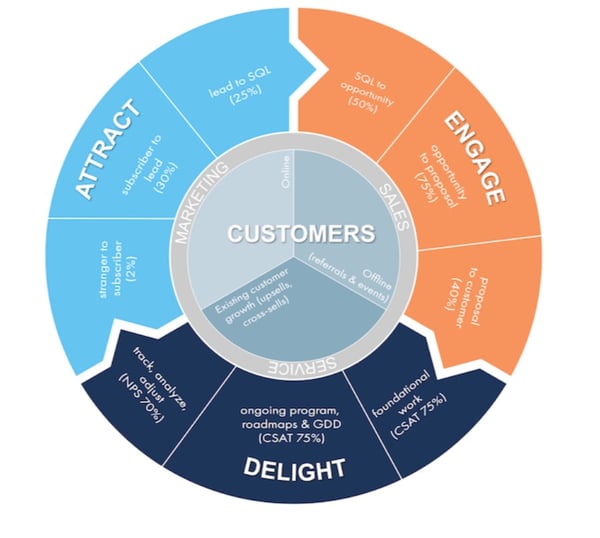What Does Organizational Buy-In Have to do With Inbound Results?
Written by

As a marketing manager/director of a complex business, internal stakeholders look to you for answers. Moreover, they look to you for results. What business growth initiatives are underway? How successful are they? What are the short- and long-term projections? Are the analytics aligning with goals?
With all of these expectations, it may feel like you are solely responsible for meeting them. Retreating into solitary “get it done” mode may be effective in certain instances, but not if you’re starting an inbound marketing program. Inbound is most successful when everyone in the organization is on board and engaged in the process.
Who You Need Buy-In From and Why
So, what do I mean by “everyone” being on board with inbound? Leadership/C-suite decision makers. Sales leadership and reps. Operations/Customer Service. Subject matter experts (SMEs) that can be tapped for authoritative content — which is the cornerstone of inbound.
It’s not a nebulous push for team unity. Inbound is structured on an interconnected flywheel methodology:
 Given the flywheel, it stands to reason that inbound is predicated on momentum. How fast the flywheel spins is directly proportional to how much, and where, force is applied, and how much friction the flywheel encounters. Removing as many impediments as possible by fostering full team buy-in gets — and keeps — the flywheel spinning because people are empowered by, and engaged with, inbound.
Given the flywheel, it stands to reason that inbound is predicated on momentum. How fast the flywheel spins is directly proportional to how much, and where, force is applied, and how much friction the flywheel encounters. Removing as many impediments as possible by fostering full team buy-in gets — and keeps — the flywheel spinning because people are empowered by, and engaged with, inbound.
Related: Designing a Successful Inbound Marketing Program Using the Flywheel
What’s At Risk if I Don’t Have Buy-In?
Any touchpoint by a prospect or customer is susceptible to causing momentum-stealing friction if you’re asking: What if my organization isn’t ready to go all in on inbound?
It’s a valid question, and not knowing the answer could mean setting yourself up for difficulties in showing the benefits — and successes — of an inbound program. In particular, it shines a light on the very real risks of a lack of readiness for an inbound marketing program and having full buy-in behind it:
- Unrealistic expectations will be set: A lack of understanding that inbound requires time to gain traction could lead to unrealistic expectations about immediate ROI. In turn, Leadership and Sales, among others, could advocate for bailing prematurely on an inbound strategy — perhaps just before a major breakthrough.
- Leads will languish: Not adhering to the inbound service level agreement (SLA) structure between Sales and Marketing as it relates to qualification, handoffs, and committed lead management will end business relationships before they begin. Prospects slipping through the inter-department cracks because of Sales and Marketing misalignment make it nearly impossible to demonstrate revenue ROI.
- The customer experience will suffer: Inbound is all about being helpful and transparent. If Operations/Customer Service team members don’t embrace inbound, the customer experience will feel inauthentic. Why? Marketing won’t be able to tell stories of delight simply because they won’t know them. Transparency and feedback from those responsible for delighting customers should fuel content that resonates with prospects such as case studies and testimonials — thereby turning customers into promoters. Worst case scenario? A disengaged Operations/Customer Service team may not generate stories worth telling!
Thinking Like Publishers
Quality content is imperative for inbound marketing success. That means everyone — regardless of department or position — is tasked with thinking like a publisher.
In some instances, that task takes the form of being a subject matter expert (SME) and contributing to content development that speaks to specific audience pain points, challenges, and solutions. Content that’s relevant to visitors ramps up conversion potential. Putting the right information in front of the right people at the right time in the buyer’s journey compels action.
In other cases, leveraging firsthand experiences to shape content can hit the mark. The Sales team can be particularly helpful in this area because — you guessed it — they are most likely to hear the questions, problems, needs, and opinions of prospects and customers. That firsthand information can translate to exceptionally compelling content and blog article topics.
Finally, there’s the distribution of content to consider. Not all team members across your organization will necessarily be generating content. However, they are still instrumental to an inbound strategy. Distributing and promoting content by sharing on social platforms and industry forums is powerful — and easy to do.
Inbound marketing is powerful, and savvy marketing managers understand how to use it to their organization’s best advantage. Learn more about measuring inbound success and demonstrating meaningful results to key stakeholders using our tip sheet, 7 Marketing Metrics B2B Executives Care About.
Subscribe To Our Blog
Information. Insights. Ideas. Get notified every time a new Weidert Group blog article is published – subscribe now!
You May Also Like...

Artificial Intelligence
Revenue-Driving B2B Content Marketing Strategy with Andy Crestodina

Artificial Intelligence
AI Agents Are Here—How Smart Businesses Are Using Them Now

Inbound Marketing
Podcasting Playbook: What We Learned After 100 Days of Running a B2B Podcast
Accelerate Your Growth with
Weidert Group
If you’re ready to explore a partnership, request a personalized consultation with our team.

